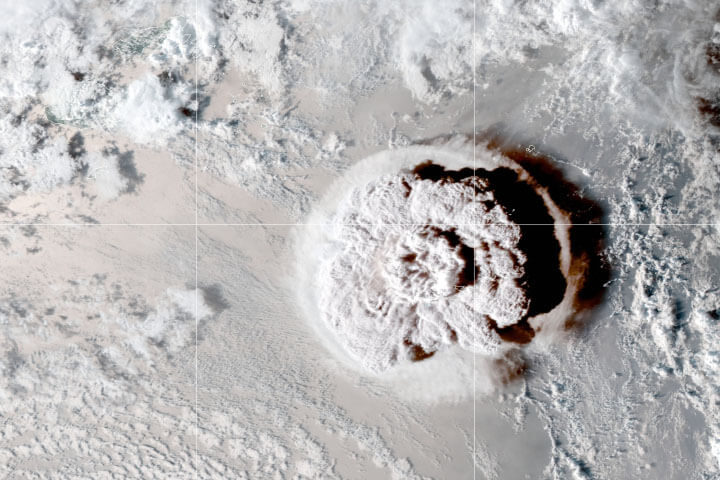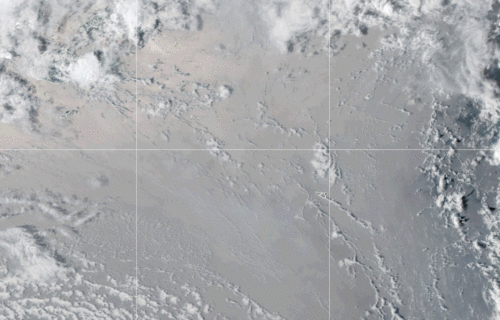BATH, England — A volcanic eruption in Tonga that triggered a tsunami was among the most powerful ever recorded, sending shockwaves around the world and into the edge of space, according to new research. It was as big as notorious Krakatoa in 1883 and sent gravity waves reverberating around the Earth reaching more than 60 miles into the upper atmosphere.
The volcanic eruption was hundreds of times stronger than the atomic bomb dropped on Hiroshima during World War II. It affected radio communications, GPS systems, telescopes, and even weather systems.
“This was a genuinely huge explosion, and truly unique in terms of what has been observed by science to date. We have never seen atmospheric waves going round the whole world before, or at this speed – they were traveling very close to the theoretical limit,” says lead author Dr. Corwin Wright, of the Centre for Space, Atmospheric and Oceanic Science at the University of Bath, in a statement. “The eruption was an amazing natural experiment. The data we have been able to gather on it will enhance our understanding of our atmosphere and will help us improve our weather and climate models.”
There were only three confirmed deaths — a miracle given whole communities were left under a blanket of volcanic ash and mud from the massive tidal wave that followed. About 84 percent of the total population was affected.

Before the eruption in January this year, the Hunga Tonga-Hunga Ha’apai volcanic island was two separate islands. They were joined by new land formed in 2015. All that is gone, along with large chunks of the two older islands.
The fact a single event dominated such a large region was described as “unique” in magnitude and speed. It could shed fresh light on the affects of global warming.
Study co-author Dr. Scott Osprey, of the National Centre for Atmospheric Science at the University of Oxford, expects to see further impacts. “Our study nicely shows how the striking display of global waves is driven by the huge amounts of seawater vaporized during the eruption,” he warns. “However, my gut feeling is there is more to come. As the exceptional amount of water vapour spreads throughout the stratosphere, eyes will turn to the Antarctic ozone hole and just how severe it will be in the spring.”
Ozone forms an invisible protective shield between six and 30 miles above Earth’s surface. Without it, life would not be possible. As long as it remains dark, nothing happens. But when spring arrives, ultraviolet radiation from the sun reaches the Antarctic Circle and starts the process of destruction.
The international team combined extensive satellite data with ground level infrasound and seismic instruments. After a series of smaller events beginning in December, Hunga Tonga blew on January 15, 2022, producing a vertical plume that rose more than 30 miles into the sky. Heat released from water and hot ash fuelled gravity waves on Earth for the next 12 hours.
The eruption also caused ripple like affects across the Pacific basin that could be seen from space. Atmospheric waves pulsated around the planet at least six times at a record 720mph – close to their maximum theoretical speed.
In the immediate aftermath, there were fears that water sources had been polluted by the thick blanket of ash, increasing the risk of diseases like cholera and diarrhoea. Testing later cleared them as safe to drink. But fine volcanic ash and emissions continued to pose a public health risk. Exposure potentially caused breathing difficulties, affected the cardiovascular system, and irritated the lungs, eyes and skin.
Dozens of people on Mango, one of the worst-hit islands, had to be relocated to the outer island of Nomuka after losing their homes and all of their personal belongings. The remote archipelago was cut off for five days because the explosions severed the sole fibre-optic sea cable bringing internet to the island.
The August 1883 eruption of Krakatoa was the worst in modern history. The volcano, found in the middle of the Sunda Strait in between two of Indonesia’s largest islands, was on a small island which disappeared almost overnight.
The eruption was so loud it could be heard in Reunion, some 3,000 miles away. As the volcano collapsed into the sea, it generated a tsunami 37 metres high – tall enough to submerge a six-storey building. And as the wave raced along the shoreline of the Sunda Strait, it destroyed 300 towns and villages, and killed more than 36,000 people.
If it were to erupt again with such force and fury – as is likely to happen – it would cause even more devastation.
The study is in the journal Nature.
Report by South West News Service writer Mark Waghorn.
